
by Carrie Stevenson | Nov 25, 2014
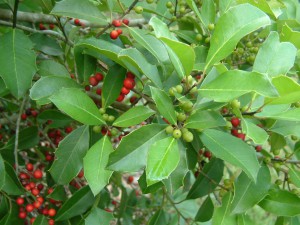
The Savannah holly has beautiful leaves and berries throughout the winter. Photo credit: Carrie Stevenson
As the holiday season comes upon us, many folks will be spending their weekends scouring tree farms and mall parking lots for the perfect Christmas tree. There are many very realistic-looking options for artificial trees these days, and they are a great way for families to reduce waste by reusing the same tree year after year. However, a live Christmas tree brings greenery inside, smells wonderful, and provides a central focus for many of our holiday traditions. Many cut trees will last over a month with good watering, but when the holidays are over, what do you do with your tree?
Many cities and counties offer a Christmas tree recycling program, in which trees can be left at drop-off sites or on the curb for pickup. Most municipalities turn the trees into mulch and use it at public facilities. Many individuals reuse trees by placing them in lakes or other water bodies as fish habitats, creating reefs for hiding and nesting. However, be sure and check with local environmental agencies before placing trees under water. If you own a good bit of land or a wooded area, you can lay your old tree out for small mammals and birds to use as shelter. It will eventually biodegrade and add nutrients to the soil. Be sure that if you take advantage of any of these recycling options that you remove all ornaments, tinsel, or other decorations which could be hazardous to animals and/or wood-chipping machines.
There is an option to truly keep your tree evergreen—a live Christmas tree! Many retailers sell potted trees that can be brought inside and decorated, then planted outside after the season is over. One of the plants often associated with this festive time of year is holly, which is an excellent choice for evergreen color throughout the year. There are many native varieties, such as yaupon holly for drier areas and myrtle-leaved holly for wetlands. Hollies are typically used as shrubs in the landscape, although many species can grow into small trees if allowed; the East Palatka holly can be as tall as 45 feet at maturity! Hollies are also an excellent food choice for attracting birds, and the shrubs work wonderfully as a natural screen. While their branches aren’t quite as sturdy as some of the northern varieties, native Atlantic white or Eastern red cedar–or even some local pines–are also excellent evergreen species that can be used.
A live tree or one planted and decorated outdoors is a wonderful way to commemorate a special Christmas and help provide wildlife habitat year-round.

by Mary Salinas | Oct 21, 2014
This autumn you may notice shrubs with long, arching branches sporting clusters of shiny purple berries. That beautiful sight is the Beautyberry, or Callicarpa americana. This native is found throughout Florida and the southern United States, west into Texas and north to Tennessee and Virginia.
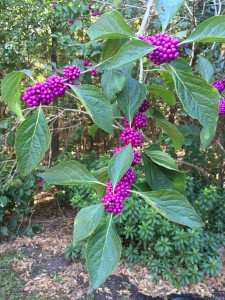
Beautyberry in the fall. Photo credit: Mary Derrick, UF IFAS Extension.
In the spring, lavender flowers adorn the branches and are a favorite of bees. The flowers eventually give way to the shiny purple berries in the fall. Birds find the berries very attractive and will feast on them when found. Mockingbirds and cardinals are especially fond of them. If you plant this shrub for the birds, one or two plants will provide more than enough of the berries to satisfy their appetites.
Beautyberry is adaptable to a wide variety of soils and moisture. After it gets established it is drought tolerant, however it can also do well in a moist area. A spot in your garden that gets partial sun is a perfect location. Plants in too much sun sometimes get a bit yellow and those in too much shade get leggy and don’t set as much fruit. Beautyberry is deciduous, meaning that it will lose all its leaves in the winter. Therefore, you may want to place it in an area of your yard where it won’t be a focal point in the winter.
This lovely plant is usually readily available at independent nurseries. If you prefer to grow your own, beautyberry is easy to propagate and grows rapidly. Snip off an approximate 6-inch piece from the end of a stem; the cut piece should have 5 sets of leaves. Snip off the bottom 2 sets of leaves – this part of the stem will be in the soil and roots will emerge from where the leaves were removed. Also snip off the top of the stem to include the top set of leaves. Your cutting will end up with only 2 sets of leaves. Immediately put the cutting in a good potting soil, making sure that the lower part of the stem where the 2 sets of leaves were removed is below the soil line. Keep the soil moist as the cutting develops a good root system.
You and the birds will enjoy this lovely shrub for years to come!
by Les Harrison | Oct 20, 2014
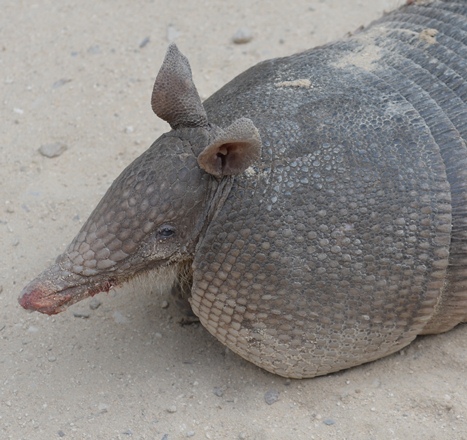
Appearing clumsy and bumbling at first glance, these exotic invaders quickly damage landscapes in search of tasty insects.
It can be pretty discouraging to step out one morning to find a lawn pock-marked like the lunar surface. Stunned surprise then anger is usually the owner’s response.
The offender is not the neighborhood teenager with a reputation for inappropriate practical jokes. The offender is most likely an armadillo, sometimes identified as a Florida-speed-bump or a Possum-on-the-half-shell.
Armadillos eat mostly adult insects and their larvae. They incessantly dig holes in lawns and landscapes in their search for food, many times uprooting plants and turf in their food search. Their holes are approximately one to three inches deep and three to five inches wide.
Using insecticides to decrease the armadillo food supply is not guaranteed, but may help reduce the digging. In cases where there is a large, and always ravenous, armadillo population this reduction of food may increase digging activity as they search more diligently for a smaller food supply.
Another consideration is all chemical treatments have to be re-applied on a permanent basis for impact. Always read and follow label instructions for safe use of insecticides.
To add insult to landscape injury, armadillos burrow under driveways, foundations and patios potentially causing structural damage. Additionally, their burrows in pastures pose a potential leg-injury hazard to livestock.
Burrows openings are approximately seven to eight inches in diameter, about the size of a one-gallon plastic jug, and up to 15 feet in length. The sandy soil is piled up right outside the burrow entrance. Armadillos usually rest in a deep burrow during the day and are most active after dark.
Because armadillos are nocturnal, trapping techniques designed to capture them as they emerge from their burrows should be applied late in the afternoon and checked several hours after darkness. Fencing is another potential option to discourage the presence of armadillos.
Several live-trapping techniques can be used to capture armadillos as they exit of their burrows. One method is to firmly insert a six-inch diameter PVC pipe into the entrance of an active burrow. Adult armadillos will get stuck in the pipe as they try to exit. Another option involves a nylon throw-net staked down to cover the burrow entrance. Armadillos will get tangled in the net as they emerge.
Some can be discouraged from returning to their burrows by filling the hole with a mixture of dirt and mothballs after they have departed for a night of foraging. Laying chicken-wire along a patio, driveway or house foundation will discourage burrowing.
Armadillos can also be trapped using a raccoon-size metal trap, available from local pest control, feed and home improvement stores. These animals are more likely to enter a cage trap with leaf litter or soil placed over the wire bottom.
Suggested baits for the trap are live earthworms or meal worms in surrounding soil placed in hanging bags made of old nylon stockings. Overripe or spoiled fruit which will attract insects may be used as bait. Poison baits are illegal and no chemical repellents or fumigants are registered for use in Florida.
Relocating problem animals is not recommended because it only transfers the problem elsewhere and can spread disease.
To learn more about controlling armadillos contact your local UF/IFAS Extension Office or read Baiting the Nine-banded Armadillo at http://edis.ifas.ufl.edu/uw362
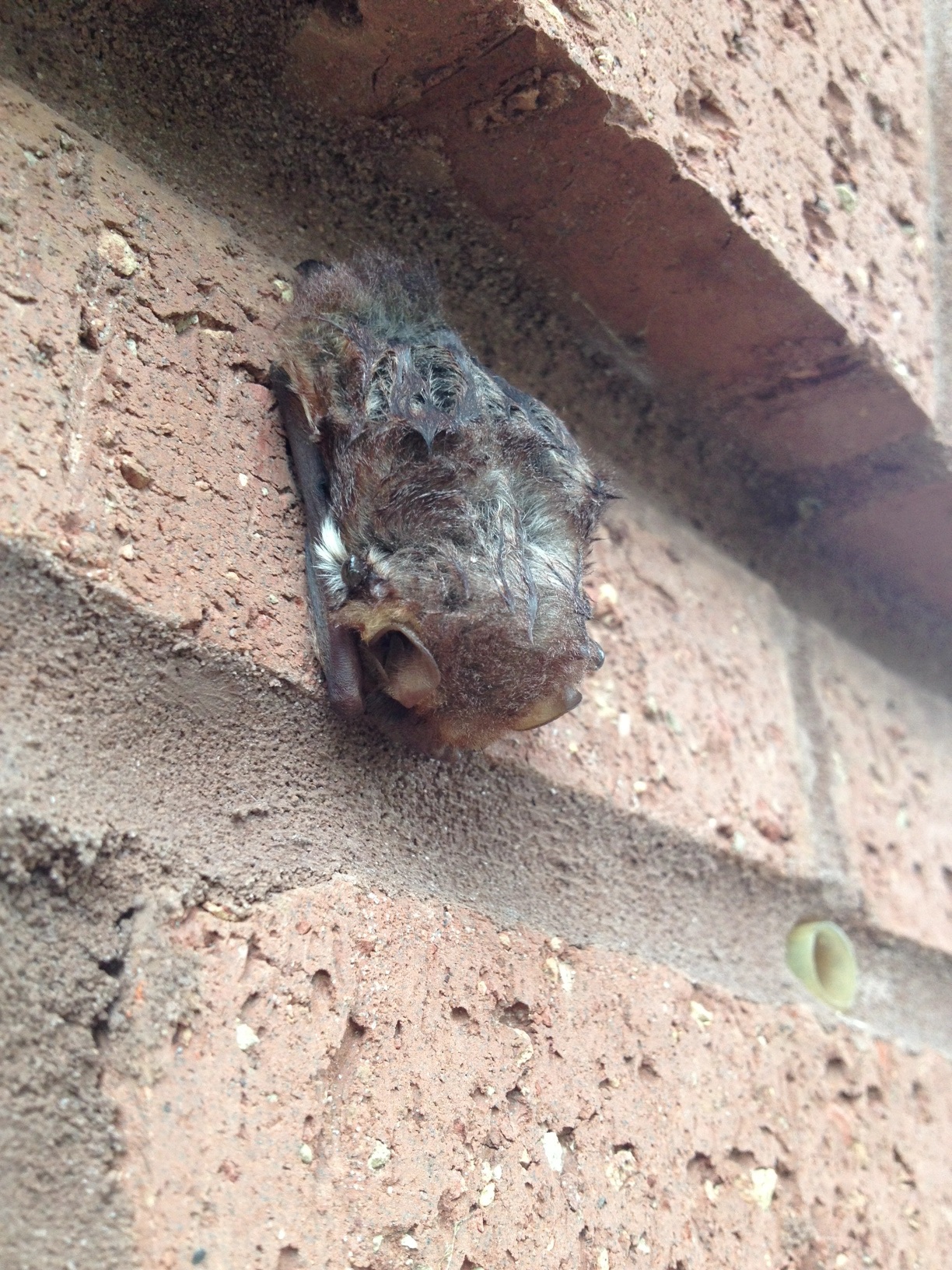
by Carrie Stevenson | Sep 30, 2014
Last week, the Okaloosa County Health Department issued a rabies alert after three bats were determined to have the illness. A “drive-through” rabies vaccine clinic was organized for pets, and warnings were issued throughout the region about making contact with wild animals. One radio broadcast played an interview in which a health department staffer urged people “not to attract wildlife to your yard.” While they were focusing on unsecured trash and pet food, I found this advice unsettling, for as an Extension Agent I’ve promoted the practice of attracting wildlife to yards for many years—birds, butterflies, and even (especially) bats. Raccoons, not bats, have the greatest incidence of rabies (based on data collected from 1992-2011), by a factor of almost seven times that of bats. In the scare of a rabies outbreak, it can be easy to overreact or overlook the many benefits that wildlife provide to our neighborhoods.
There are, of course, practical ways to go about living with wildlife without endangering your health or that of your family and pets (including making sure pets have the rabies vaccine).
Use Caution around Injured Wildlife
Most wildlife rescue organizations do not have the staff to pick up injured animals and ask those who find one to bring them in. However, sick or injured animals may respond aggressively as an intuitive protective measure. If you are taking an animal to a wildlife rehabilitator, be sure to approach it gently and use a blanket or large towel to pick up the animal, and place it gently in a box with a ventilated lid. Great information on responding to injured or deserted animals can be found at the Wildlife Sanctuary of Northwest Florida website. Keep in mind that bats are flying animals and spend almost no time on the ground. They do not chase people and are primarily concerned with catching insect prey. If you find a bat on the ground, it is most likely sick. County animal control or private wildlife responders can also help if you are concerned about interacting with a sick animal.
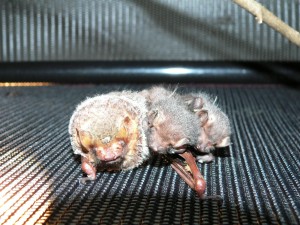
These twin Seminole bat pups were found on the ground with their mother and nursed back to health at the Wildlife Sanctuary of Northwest Florida. Photo credit: Carrie Stevenson
Use Care When Retrieving Dead Animals
When bird flu, West Nile or rabies hits an area, health departments sometimes ask that suspect animals be reported for testing to confirm the cause of death. Even if you are just disposing of the animal, be sure to use gloves and place the animal in a sealable plastic bag to prevent spreading germs, and wash your hands after handling it. If burying, place at least three feet deep and away from wells or water sources.
Enjoy Wildlife from a Distance
Disturbing healthy animals while they are feeding or resting can cause unnecessary stress and reduce their hunting success. Animals’ natural behaviors are fascinating to watch, so be sure and do so from a respectful distance to allow them to interact normally with their environment.
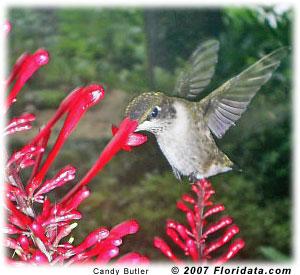
by Sheila Dunning | Sep 23, 2014

Photo Credit: Candy Butler, Floridata.com
Looking to add something to brighten your landscape this autumn? Firespike (Odontonema strictum) is a prolific fall bloomer with red tubular flowers that are very popular with hummingbirds and butterflies. Its glossy dark green leaves make an attractive large plant that will grow quite well in moderate shade to full sunlight. In frost-free areas firespike grows as an evergreen semi-woody shrub, spreading by underground sprouts and enlarging to form a thicket. In zones 8 and 9 it usually dies back to the ground in winter and resprouts in spring, producing strikingly beautiful 9-12 inch panicles of crimson flowers beginning at the end of summer and lasting into the winter each year. Firespike is native to open, semi-forested areas of Central America. It has escaped cultivation and become established in disturbed hammocks throughout peninsular Florida, but hasn’t presented an invasive plant problem. Here in the Panhandle, firespike will remain a tender perennial for most locations. It can be grown on a wide range of moderately fertile, sandy soils and is quite drought tolerant. Firespike may be best utilized in the landscape as a mass planting. Plants can be spaced about 2 feet apart to fill in the area quickly. It is one of only a few flowering plants that give good, red color in a partially shaded site. The lovely flowers make firespike an excellent candidate for the cutting garden and is a “must-have” for southern butterfly and hummingbird gardens. Additional plants can be propagated from firespike by division or cuttings. However, white-tailed deer love firespike too, and will eat the leaves, so be prepared to fence it off from “Bambi” if they are a problem in your neighborhood.
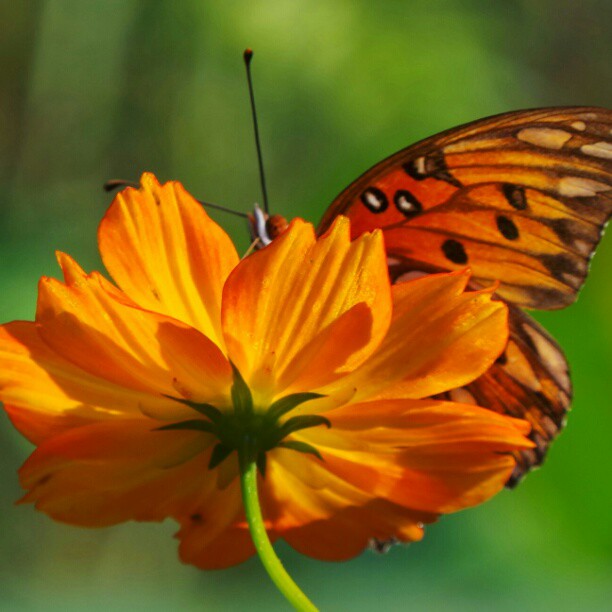
by Taylor Vandiver | Aug 4, 2014
Attracting Butterflies into Your Landscape
Have you been itching to add some life and color into your landscape? Why not plant a butterfly garden?! Butterfly gardens are a great way to add movement and life to an otherwise stagnant landscape. Most butterfly gardens are not only an attractant for our Florida butterflies, but are also a magnet for hummingbirds and beneficial insects. To start your garden all you need are a few key plants.
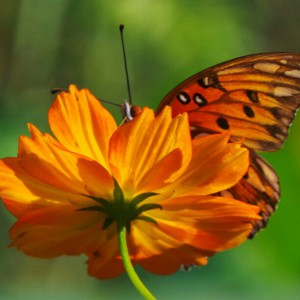
Gulf Fritillary. Photo Courtesy Scott Jackson.
Incorporate at least one host plant and one nectar plant into your garden. The host plant provides a suitable habitat for the female butterfly to lay her eggs. These eggs will hatch and the baby caterpillars will eat the leaves of the host plant. Host plants are often not as showy as nectar plants, nor are they even necessary to attract adult butterflies. However, while nectar plants invite butterflies into your garden to feed, host plants offer them a reason to stay and reproduce. And you can watch this entire cycle unfold in your own garden!
Most of your butterfly attractant plants will do best in full sun to partial shade. Try not to apply pesticides in areas where you want to maintain healthy caterpillar/butterfly populations. Providing water for butterflies is very important and easily done. One option is to fill a clay tray with sand and then place a rock in the center, where the butterfly can perch. Keep the sand wet, but avoid standing water. Feel free to contact your local extension office for more information on our winged friends!
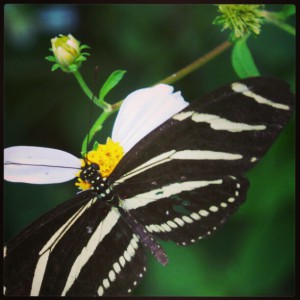
Zebra Longwing, our state butterfly! Photo courtesy Scott Jackson.
Here are a few examples of butterflies and their preferred host plants:
o Host Plants – Fennel, Parsley, Bishopsweed
o Host Plants – Pawpaw
o Host Plants – Wild Lime, Hercules-club, Citrus spp.
o Host Plants – Ash, Black Cherry, Tulip tree, Sweetbay Magnolia
o Host Plants – Partridge Pea, Cassia
o Host Plants – Passion Vines
- Zebra Longwing (State Butterfly of Florida)
o Host Plants – Passion Vines
o Host Plants – Milkweed, Butterfly Weed
Here are nectar plants that will have the butterflies swarming to your garden:
- Firebush
- Milkweed
- Blanket Flower
- Sage (Salvia spp.)
- Butterfly Bush
- Blazing Star
- Yarrow
- Pentas
- Stoke’s Aster











